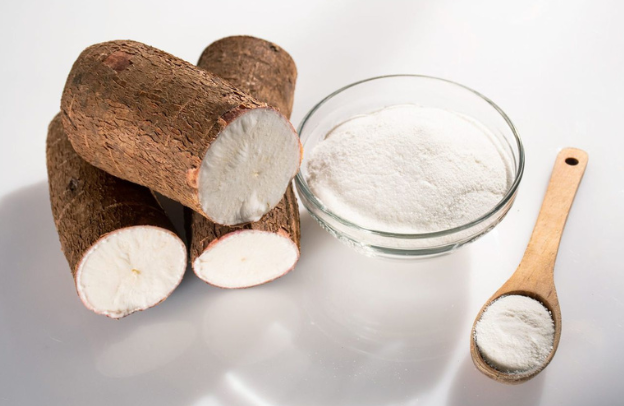Cassava Flour 101: Unlocking Culinary, Nutritional, and Economic Opportunities for the African Diaspora

Cassava flour, also known as yucca flour or manioc flour, is a gluten-free flour made from the root of the cassava plant. Imagine transforming Nigeria’s abundant cassava production into a high-value, gluten-free flour that not only feeds millions but also creates jobs and fosters sustainable growth. As a member of the African diaspora, you have a unique opportunity to leverage Nigeria’s agricultural potential and to spearhead an agribusiness revolution that could redefine food security on the continent.
Learn How to Leverage Your Story through our Story To Asset Transformation (S.A.T) Framework.
This article explores the world of cassava flour—from its traditional roots to modern innovations—and shows you how your investment and expertise can help transform a staple crop into a global commodity.
Understanding the Nigeria’s Agricultural Landscape
Nigeria is endowed with fertile land and diverse agro-ecological zones. Despite having over 70 million hectares of arable land, only about 40% is actively cultivated. Agriculture contributes approximately 25% to Nigeria’s Gross Domestic Product (GDP) and employs over 35% of the nation’s workforce.
Yet, despite this vast potential, Nigeria remains a net food importer, spending billions annually to meet domestic needs. This paradox presents a tremendous opportunity for investors like you to modernize and transform Nigeria’s agricultural sector.
See also Cassava Farming: A Gateway to Profitable Agribusiness for the African Diaspora
Among the many crops grown in Nigeria, cassava stands out as a powerhouse. Nigeria is the world’s largest producer of cassava, with an annual output exceeding 59 million tonnes. Cassava is more than just a subsistence crop; it has the potential to drive industrial and export growth if processed into high-value products such as cassava flour, starch, and bioethanol.
Your investment in this sector can help bridge the gap between raw production and modern consumption, unlocking economic value and reducing Nigeria’s reliance on food imports.
The Nutritional and Economic Value of Cassava Flour
Cassava flour, also known as yucca or manioc flour, is produced by processing the starchy root of the cassava plant. It is naturally gluten-free and rich in carbohydrates, making it an excellent source of dietary energy.
A 100-gram serving of cassava flour provides approximately 130 calories and between 75 to 80 grams of carbohydrates. For populations where food insecurity is rampant, such energy-dense foods are critical.
In addition to its energy content, cassava flour offers several other benefits:
- Gluten-Free Alternative: Cassava flour is ideal for people with celiac disease or gluten intolerance. Its ability to substitute wheat flour in various recipes makes it attractive in global health food markets.
- Dietary Fiber: The flour is a good source of dietary fiber, which helps regulate digestion and lower cholesterol levels.
- Cost-Effective: Cassava is inexpensive to grow and process, which means the resulting flour is affordable—a crucial factor for low-income consumers.
- Sustainable Crop: Cassava is drought-tolerant and can grow in poor soils, making it a reliable crop even in adverse conditions. This resilience is particularly important as climate change continues to affect traditional agricultural practices.
These nutritional and environmental benefits position cassava flour as not only a healthy food ingredient but also as a driver of economic growth and food security in Nigeria.
See also: The Economic Value of Cassava Farming in Nigeria: Opportunities and Challenges
Traditional Uses of Cassava Flour in African Cuisine
Cassava flour has been a staple in many traditional African diets for centuries. In Nigeria, it is a key ingredient in several iconic dishes:
- Fufu and Eba: These starchy, dough-like foods are made from fermented and dried cassava flour. They serve as the main carbohydrate source in many households and are traditionally paired with richly flavored soups and stews.
- Garri: Produced by fermenting, roasting, and granulating cassava, garri is consumed as a snack or reconstituted into a porridge. Its affordability and versatility have made it a household staple across Nigeria.
These traditional uses underscore cassava flour’s role in ensuring food security and preserving cultural heritage. The methods used to produce cassava flour have been honed over generations, and they represent an essential part of Africa’s culinary legacy.
Cassava Flour in Contemporary Cuisine
In recent years, cassava flour has transcended its traditional roles to become a trendy ingredient in modern culinary arts. Global consumers are increasingly seeking gluten-free and healthier alternatives to wheat flour, and cassava flour has emerged as a promising option. Modern chefs and food entrepreneurs are experimenting with cassava flour in a variety of innovative ways:
- Gluten-Free Baking: Cassava flour is used to make breads, cakes, and cookies that cater to the growing market of health-conscious consumers and those with gluten intolerance.
- Pasta and Noodles: Some innovators have developed recipes for cassava-based pasta, which offers a unique texture and flavor profile while remaining gluten-free.
- Snack Foods: Cassava flour is being used to produce crispy chips, crackers, and other snack items that appeal to both local and international markets.
- Fusion Cuisine: Modern African restaurants are incorporating cassava flour into contemporary dishes, blending traditional flavors with modern culinary techniques. This fusion not only preserves cultural heritage but also opens new avenues for creative expression.
Economic Opportunities for Diaspora Entrepreneurs
Your investment in the cassava flour value chain can yield substantial economic returns while simultaneously addressing food security issues. Here’s why this sector is so attractive:
1. High Market Demand and Export Potential
Nigeria’s vast production of cassava is underutilized when it comes to value addition. While Nigeria produces over 59 million tonnes of cassava annually (FAO, 2022), only a small fraction is processed into flour and other high-value products. This leaves a massive gap that can be filled through modern processing techniques.
The global market for gluten-free products is booming, with the demand for cassava flour steadily rising among health-conscious consumers in Europe, North America, and Asia (Statista, 2023). By establishing efficient processing plants, you can capture a significant share of this market and position Nigeria as a leading exporter of cassava flour.
2. Job Creation and Rural Development
Investing in cassava flour processing has a ripple effect on rural economies. Small-scale farmers who cultivate cassava benefit from guaranteed markets and better prices, leading to increased household incomes and improved living standards.
Moreover, the processing facilities themselves create numerous jobs—from machine operators and quality control technicians to logistics personnel and administrative staff.
Empowering rural communities in this way can help curb urban migration and foster overall community development. Women, who are often heavily involved in cassava production and processing, stand to benefit significantly from such investments (Nigerian Bureau of Statistics, 2023).
3. Boosting the Non-Oil Economy
Nigeria’s economy has long been dominated by oil, but this sector is volatile and unsustainable in the long term. Diversifying the economy through agribusiness is crucial. By modernizing cassava processing and adding value to raw production, Nigeria can reduce its dependency on oil revenues and food imports.
Economic models suggest that if Nigeria processes just 20% of its cassava into high-quality flour and starch, it could potentially add billions of dollars to its GDP (PwC Nigeria, 2023).
4. Sustainable Growth and Environmental Impact
Cassava is an environmentally sustainable crop due to its drought tolerance and low input requirements. Unlike many other crops, cassava can grow in poor soils and does not require excessive fertilizers or pesticides.
This sustainability makes it a key crop in the context of climate change. Your investment in cassava flour processing not only drives economic growth but also contributes to environmental conservation—a win-win for both profit and planet.
See also: Preventing Soil-Borne Diseases in Cassava Farming: Crop Rotation Strategies for Nigerian Farmers
Strategies for Success: Your Roadmap to Agribusiness Excellence
To maximize the economic and social impact of cassava flour processing, you must adopt a strategic approach. Here are several actionable steps to consider:
1. Invest in Modern Processing Facilities
Establish state-of-the-art processing plants that use automated peelers, graters, fermenters, and dryers. These facilities can dramatically increase efficiency, reduce labor costs, and ensure consistent product quality. Look for opportunities to leverage technology to monitor and control every stage of the processing chain, from peeling and washing to milling and packaging.
2. Develop Strategic Partnerships
Success in Nigeria’s agribusiness sector relies on strong local partnerships. Collaborate with:
- Farmers’ Cooperatives: Ensure a steady supply of raw cassava while supporting local agriculture.
- Research Institutions: Partner with organizations like the International Institute of Tropical Agriculture (IITA) for improved cassava varieties and advanced processing techniques.
- Export Agencies: Work with the Nigerian Export Promotion Council (NEPC) to navigate international trade regulations and access global markets.
3. Leverage Financial Instruments and Government Incentives
Utilize diaspora bonds, venture capital, and microfinance schemes targeted at agribusiness. The Nigerian government offers several incentives, such as tax breaks and subsidized loans through programs like the Nigeria Incentive-Based Risk Sharing System for Agricultural Lending (NIRSAL). These financial tools can significantly reduce your risk and enhance profitability.
4. Embrace Digital Technology and Innovation
Adopt AI-driven precision agriculture, blockchain for supply chain transparency, and IoT devices to monitor processing efficiency and quality. Digital platforms can also connect local farmers with international markets, ensuring that your processed cassava flour meets global standards and attracts premium prices.
5. Advocate for Supportive Policies and Infrastructure Development
Engage with policymakers to promote agriculture-friendly legislation that supports agribusiness. Advocate for improvements in rural infrastructure—such as roads, cold storage, and power supply—which are critical to reducing post-harvest losses and enhancing market access. Your influence can help shape an environment conducive to sustainable agribusiness growth.
The African Diaspora: Your Role in Transforming Nigeria’s Agribusiness Landscape
As a member of the African diaspora, you have both the means and the motivation to catalyze Nigeria’s agricultural transformation. Your global perspective, coupled with access to capital and technology, can bridge the gap between traditional farming practices and modern agribusiness solutions.
Direct Investment in Agribusiness Ventures
Consider establishing or joining investment funds that focus specifically on modernizing Nigeria’s cassava value chain. Your investment can finance everything from state-of-the-art processing plants to logistical infrastructure and research initiatives aimed at improving cassava varieties and processing methods.
Knowledge Transfer and Technology Adoption
Leverage your experience and connections to introduce innovative practices and technologies to local farmers. Collaborate with digital agriculture platforms like ThriveAgric and Farmcrowdy, which have already demonstrated success in connecting diaspora investors with Nigerian agribusiness projects.
By sharing advanced techniques—from AI-driven crop management to automated processing—you can help local communities modernize their operations and increase yields.
Building Strategic Networks and Advocacy
Use your global network to forge partnerships with international buyers, research institutions, and policy advocacy groups. By participating in industry conferences and engaging with organizations such as the African Diaspora Network (ADN), you can advocate for policies that support agribusiness, promote trade, and attract further investment into Nigeria’s agricultural sector.
Economic, Social, and Nutritional Transformation
Your investment in cassava flour processing isn’t merely about financial returns—it is about creating a lasting impact that transforms lives and uplifts communities.
Economic Diversification and Growth
Modernizing the cassava value chain can diversify Nigeria’s economy away from its heavy reliance on oil. By developing a robust agribusiness sector, Nigeria can reduce its food import bill, generate substantial export revenue, and drive overall economic growth.
As the global market for cassava-based products grows—projected to reach $8 billion by 2027 (Statista, 2023)—the economic benefits of your investment will multiply.
Job Creation and Rural Empowerment
Investing in cassava processing has the potential to create thousands of jobs across the entire value chain. Rural communities, where cassava farming is a primary livelihood, will benefit from modern processing facilities, enhanced infrastructure, and improved market access.
Women, who play a significant role in cassava cultivation and processing, will especially benefit from increased income opportunities, leading to greater social and economic empowerment (Nigerian Bureau of Statistics, 2023).
Enhancing Food Security and Nutritional Health
Cassava is a reliable source of energy and, when processed correctly, can help combat malnutrition and vitamin A deficiency—a major public health concern in many parts of Africa (UNICEF, 2023). By investing in improved processing methods that preserve nutritional value and reduce toxins, you contribute to creating a stable, nutritious food supply that can withstand the challenges of climate change. This is not only an economic opportunity but a humanitarian one, with the potential to improve millions of lives.
Transforming Cassava into a Global Success Story
Imagine a future where Nigeria’s cassava fields are buzzing with modern farms and processing plants, where raw cassava is transformed into high-quality, value-added products that are exported around the world. In the future:
- Processed Cassava Products such as gluten-free flour, industrial starch, and bioethanol dominate international markets, driving significant revenue.
- Local Communities thrive as smallholder farmers, supported by modern agribusiness practices, earn sustainable incomes and experience enhanced living standards.
- Food Security is reinforced, with a stable and affordable food supply available even during climate-induced crop failures.
- Economic Diversification is achieved, reducing Nigeria’s reliance on oil and positioning it as a leader in sustainable agriculture.
This is not a distant dream but a tangible possibility that can be realized through strategic investment, technological innovation, and collaborative partnerships.
See also: How to Grow Cassava to Increase Your Harvest
Your Moment to Shape Africa’s Future is Now
Nigeria’s agribusiness sector is a vast, largely untapped reservoir of potential waiting for visionary investors like you. Cassava, with its unparalleled resilience and multifaceted uses, offers a unique opportunity to drive economic growth, enhance food security, and empower rural communities.
As a member of the African diaspora, your investment can be the catalyst that transforms traditional farming practices into a modern, globally competitive industry.
By modernizing cassava processing from advanced mechanical systems to cutting-edge digital solutions and by forging strategic partnerships with local farmers, research institutions, and export agencies, you can unlock a multi-billion-dollar market. In doing so, you will not only reap substantial financial returns but also contribute to a sustainable future for Nigeria and Africa as a whole.
Now is the time to act. Seize the opportunity to be at the forefront of Africa’s agribusiness revolution, create sustainable jobs, and ensure food security for millions. Your next strategic move could ignite Nigeria’s agricultural renaissance and set a precedent for economic transformation across the continent.
Learn How to Leverage Your Story through our Story To Asset Transformation (S.A.T) Framework.





